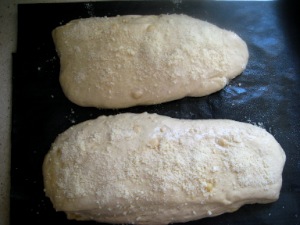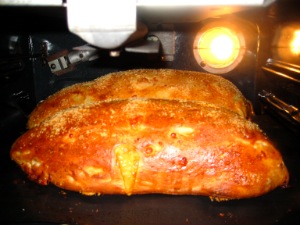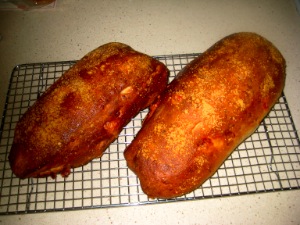|
Asiago Ciabatta
The nutty, mellow flavor of Asiago cheese adds a kick to this traditional Italian loaf.
Biga (Starter)
1 1/2 cups (6 3/8 ounces) King Arthur Unbleached All-Purpose Flour
1/4 cup (1 ounce) pumpernickel, rye, or whole wheat flour
1 cup (8 ounces) water
1/8 teaspoon instant yeast
Dough
All of the starter
2 1/2 cups (10 5/8 ounces) King Arthur Unbleached All-Purpose Flour
1/2 cup (4 ounces) water
1 tablespoon Pizza Dough Flavoring (optional)
1 1/2 teaspoons salt
1/2 teaspoon instant yeast
4 to 5 ounces Asiago or Parmesan cheese, cut into 1/4-inch dice (about 1 cup), plus extra for grating over the top of the bread
Biga: Mix all of the biga ingredients in a medium-sized bowl until well-blended. Cover the bowl, and leave it at cool room temperature (68°F-70°F) for 12 to 20 hours, until the biga is very bubbly.
Dough: Mix the biga and the remaining dough ingredients, except the cheese, using an electric mixer set on slow speed, for 2 to 4 minutes. Increase the speed to medium and mix for about 4 minutes; the dough should be soft and slightly sticky. Add additional water or flour if necessary. Mix in the cheese; don't worry if some pieces pop out. Allow the dough to rise, in a greased, covered bowl, for 1 to 2 hours, until it's very puffy. Note: You can also mix this dough in a bread machine set on the dough cycle; add the diced cheese several minutes before the end of the final kneading cycle.
Turn the dough out onto a well-floured surface, and shape it into two long loaves, about 12 x 4 inches each. Place the loaves, floured side up, onto parchment paper (if you plan to bake on an oven stone) or baking sheets. Cover the loaves with a proof cover or well-greased plastic wrap, and allow them to rise for 45 minutes, or until they're very puffy. Sprinkle them with additional grated cheese.
Bake the ciabatta in a preheated 450°F oven for 22 to 26 minutes, until it's golden brown. Remove it from the oven, and cool on a rack. Yield: 2 loaves.
I followed the recipe closely, but with a few of modifications:
1. Added one tablespoon homemade dough enhancer.
2. Added one tablespoon of dry malt extract.
3. Placed my bread directly onto baking stone by using teflon sheets atop a cookie sheet for final rising then pulling the sheets/ciabatta onto baking stone. This works great.
All the modifications were meant for maximum spring in the first 8 minutes of baking and steaming.
My crumb was much better this time. My wife said that this was my best bread ever!
|




If my second ciabatta (I've made one plain one so far) turns out like yours I'll be ecstatic!
Summer